
Archaeological excavation at Jamestown, Virginia. Overview (looking west) of area opened up on the banks of the James River on Jamestown Island that revealed traces of the fort erected by the English in 1607. (Courtesy, Association for the Preservation of Virginia Antiquities; photo, David M. Doody.)
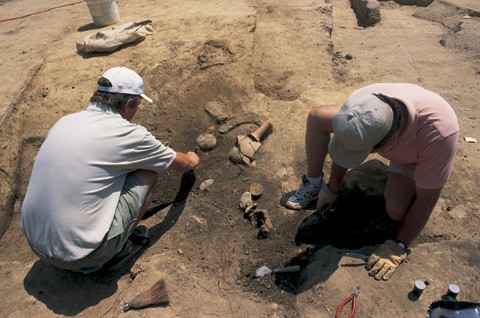
APVA archaeologists excavating artifacts from what proved to be a cellar, possibly to a blockhouse of James Fort, that was filled ca. 1610. (Courtesy, Association for the Preservation of Virginia Antiquities.)
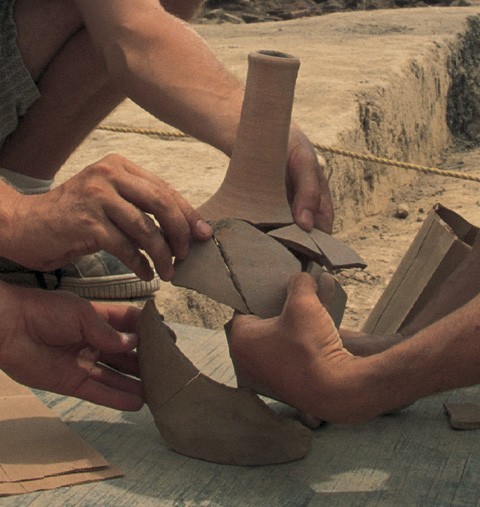
Detail of a London distilling flask as found in the course of excavation of the ca. 1610 cellar. (Courtesy, Association for the Preservation of Virginia Antiquities.)
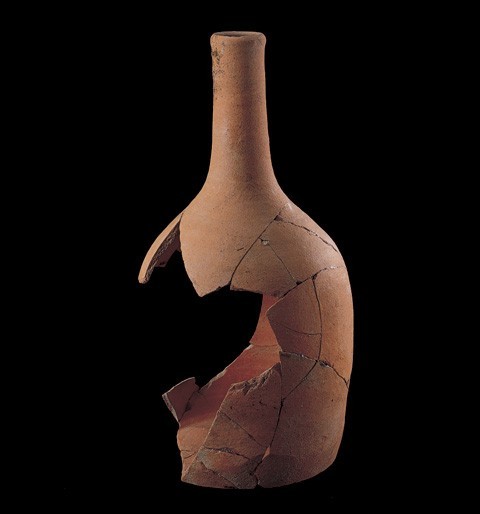
Distilling flask, London, 1600–1610. Unglazed earthenware. H. 15". (Courtesy, Association for the Preservation of Virginia Antiquities; photo, Gavin Ashworth.) The mended flask as seen in fig 3. One of a number of London coarsewares that have been recovered from James Fort’s earliest contexts. Distilling flasks are frequently found in London contexts dating to the sixteenth and seventeenth centuries. Most often associated with metal-working sites, these flasks are believed to be cucurbits, or the bottom elements of stills.
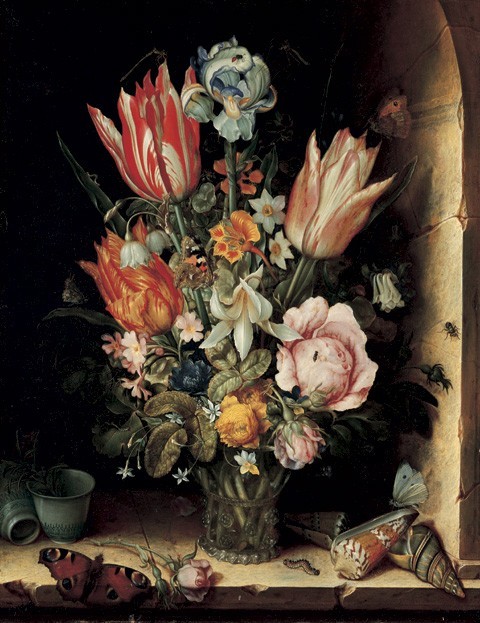
Bouquet of Flowers in Glass, Christoffel van den Berghe, 1617. (Courtesy, Philadelphia Museum of Art, John G. Johnson Collection.)
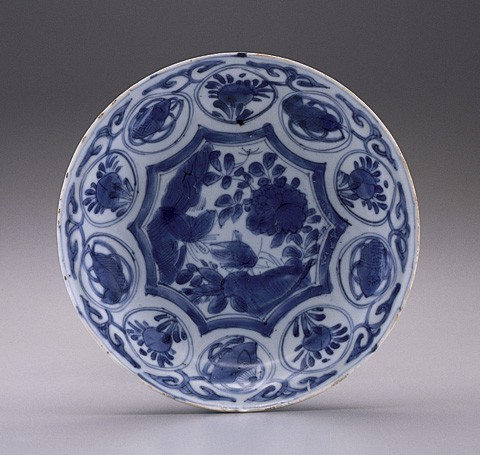
Dish, China, 1613. Hard-paste porcelain. D. 8 1/8". (Private collection; photo, Gavin Ashworth.) An example of Chinese porcelain recovered from theWitte Leeuw. The central medallion contains a grasshopper on a rock and a peony. The border is decorated with alternating flowers and symbols.
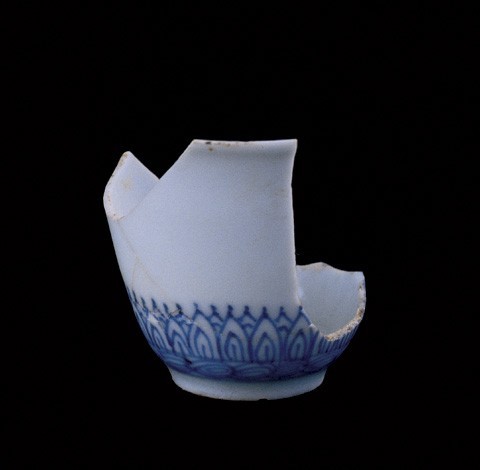
Wine cup, China, ca. 1600. Hard-paste porcelain. H. 1 11/16". (Courtesy, Association for the Preservation of Virginia Antiquities; photo, Gavin Ashworth.)
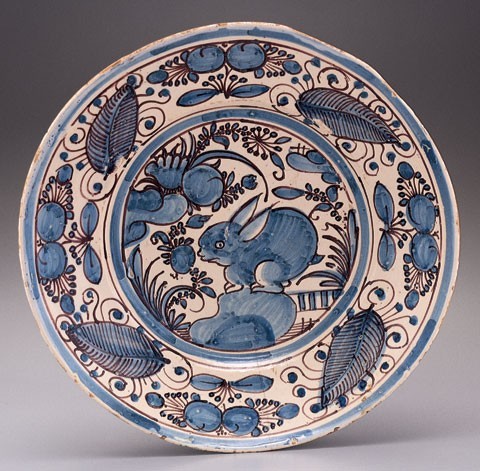
Dish, Portugal, ca. 1660. Tin-glazed earthenware. D. 14 5/8 ". (Private collection; photo, Gavin Ashworth.) An example of a Portuguese enameled dish painted in blue with manganese outlines of the Wan-Li-style decoration. Large dishes of this type have been excavated at Jamestown. A similar dish with this rabbit motif was excavated from another seventeenth-century site near Jamestown.
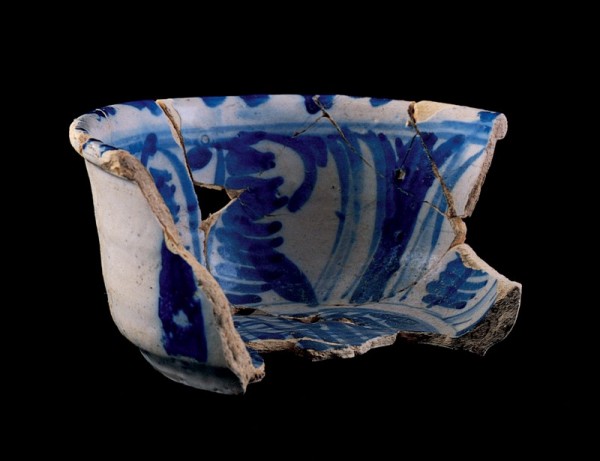
Bowl section, Portugal, ca. 1640. Tin-glazed earthenware. H. 2 9/16 ". (Courtesy, City of Newport News, Virginia, Boldrop Collection; photo, Gavin Ashworth.)

Shallow dish fragment, Portugal, ca. 1640. Tin-glazed earthenware. (Courtesy, The National Park Service, Colonial Historical National Park; photo, Gavin Ashworth.)
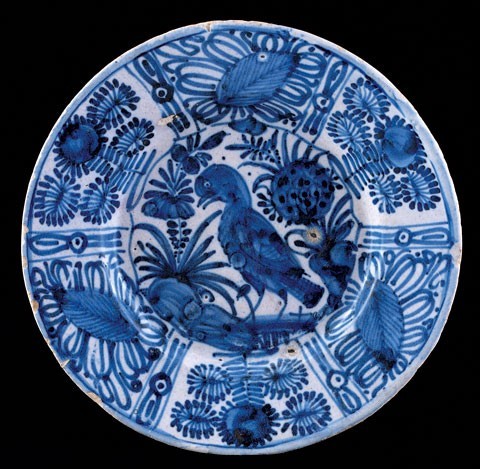
Dish, Portugal, 1620–1640. Tin-glazed earthenware. D. 9". (Private collection; photo, Gavin Ashworth.)
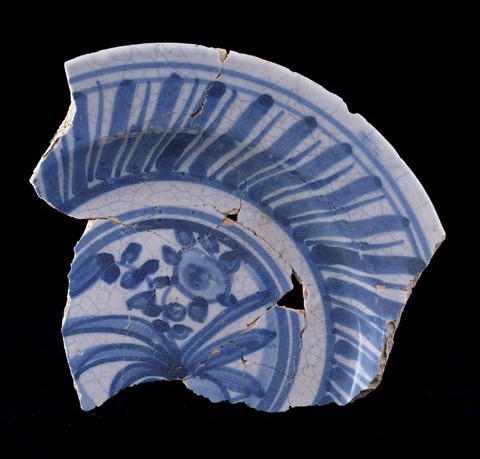
Dish fragment, Portugal, 1630–1650. Tin-glazed earthenware. D. 8". (Courtesy, Association for the Preservation of Virginia Antiquities, George Sandys Site Collection; photo, Gavin Ashworth.)
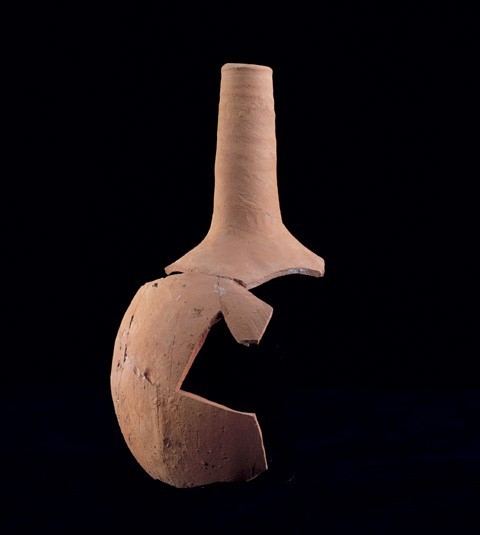
Flask, northern France, 1600–1610. Unglazed earthenware. H. 8". (Courtesy, Association for the Preservation of Virginia Antiquities; photo, Gavin Ashworth.) Example excavated from the James Fort site.

Le Dessert de Gaufreetes, Lubin Baugin, ca. 1610–1663. (Courtesy, Louvre; photo, Gerard Blot.) The wicker-covered bottle in this painting is probably made of glass but it reflects the same shape as wickered Martincamp flasks.
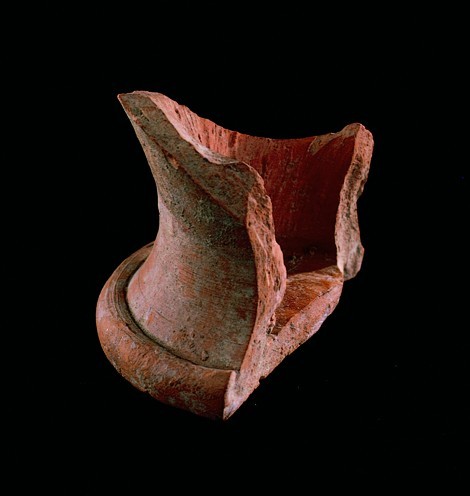
Costrel base fragment, northern Italy, 1600–1640. (Courtesy, The National Park Service, Colonial Historical National Park; photo, Gavin Ashworth.)

Costrel, northern Italy. Slipware. H. 11º". (Private collection; photo, Gavin Ashworth.)
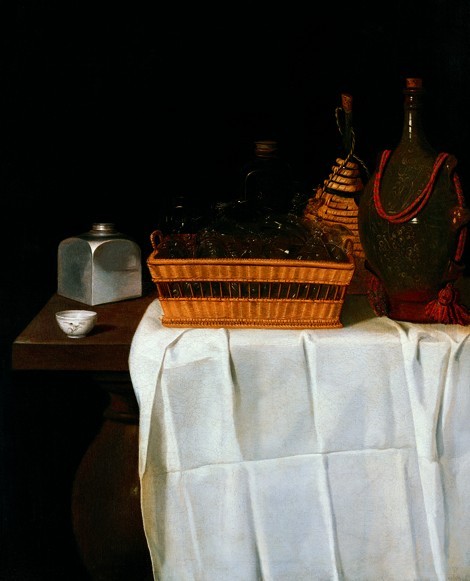
Still Life with Glasses and Bottle, Sebastian Stosskopf, 1641–1644. (Courtesy, Gemäldegalerie, Staatliche Museen Zu Berlin, Preussischer Kulturbesitz; photo, Jorg P. Anders.) The northern Italian slipware costrel, standing next to a wicker-encased glass bottle, has a cord handle looped through integral lugs.

Bowl fragment, northern Italy, 1625–1635. Slipware. H. 4 3/4". (Courtesy, Association for the Preservation of Virginia Antiquities; photo, Gavin Ashworth.) Example excavated from the James Fort site.
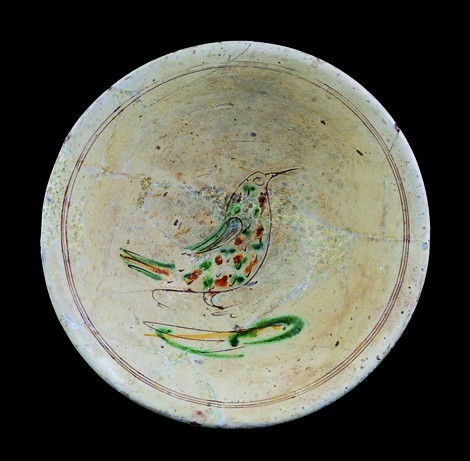
Bowl, northern Italy, 1620–1640. Slipware. D. 9 3/4". (Courtesy, The National Park Service, Colonial Historical National Park; photo, Gavin Ashworth.)

Reverse of the bowl illustrated in fig. 19. (Courtesy, The National Park Service, Colonial Historical National Park; photo, Gavin Ashworth.)

Tazza fragment, Montelupo, Italy, 1620–1640. Tin-glazed earthenware. (Courtesy, The National Park Service, Colonial Historical National Park; photo, Gavin Ashworth.)
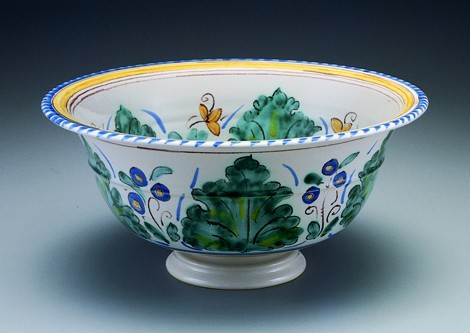
A replica of the Montelupo tazza or footed bowl represented by the archaeological fragment shown in fig. 21. H. 7". (Courtesy, Michelle Erickson; photo, Gavin Ashworth.)
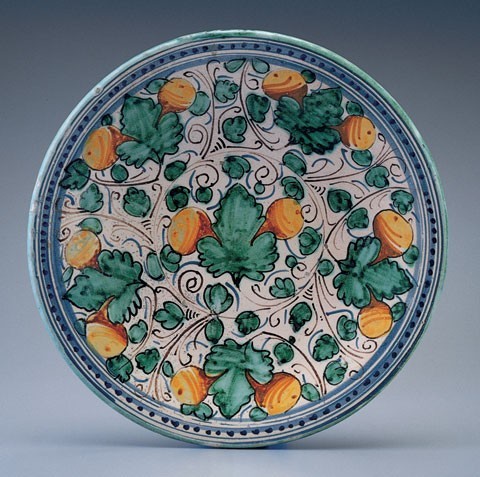
Dish, Montelupo, Italy, 1620–1640. Tin-glazed earthenware. D. 12". (Private collection; photo, Gavin Ashworth.)
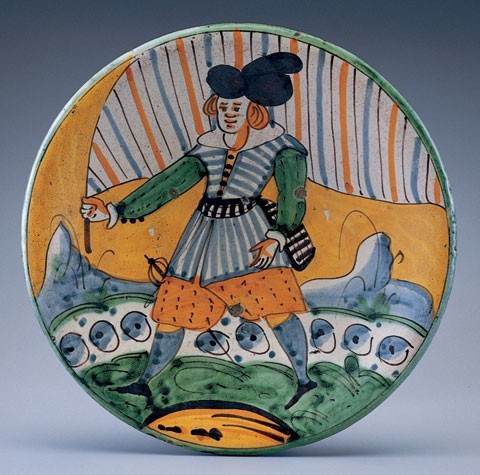
Dish, Montelupo, Italy, 1620–1640. Tin-glazed earthenware. D. 12". (Private collection; photo, Gavin Ashworth.)
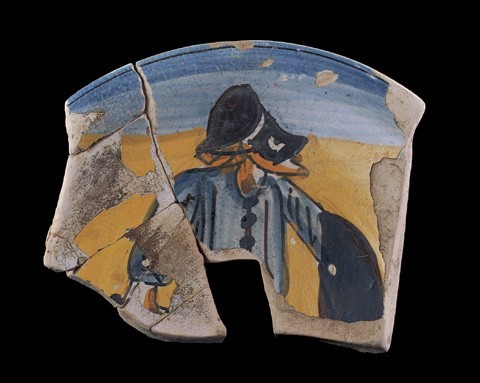
Dish fragment, Montelupo, Italy, 1630–1650. Tin-glazed earthenware. (Courtesy, Association for the Preservation of Virginia Antiquities, the Reverend Richard Buck Site Collection; photo, Gavin Ashworth.)
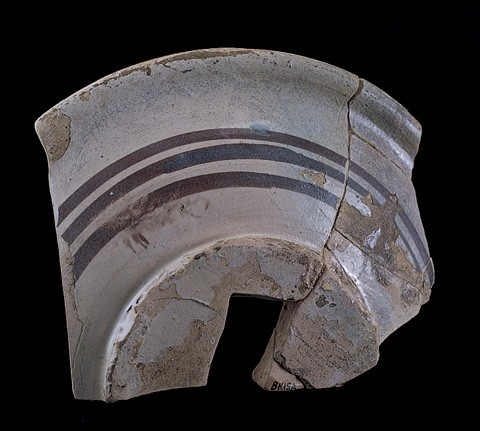
Reverse of the dish illustrated in fig. 25. (Photo, Gavin Ashworth.)

Le tombeau de Maître Andre, Claude Gillot, 1673–1723. Oil on canvas. (Courtesy, Louvre; photo, Eric Lessing.)

A Kitchen Scene, Floris van Schooten, ca. 1620–1630. (Public domain, Heinz Family Collection.) The painting shows Raeren stoneware jugs with the Seven Electors motif hanging in the background. The jugs are mounted with silver or pewter lids which increase their value and reveal their high status among seventeenth-century tablewares.
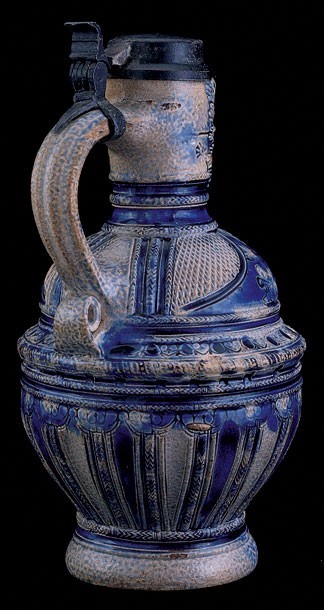
Jug, Raeren, 1600–1620. Salt-glazed stoneware. H. 10 1/4". (Private collection; photo, Gavin Ashworth.)
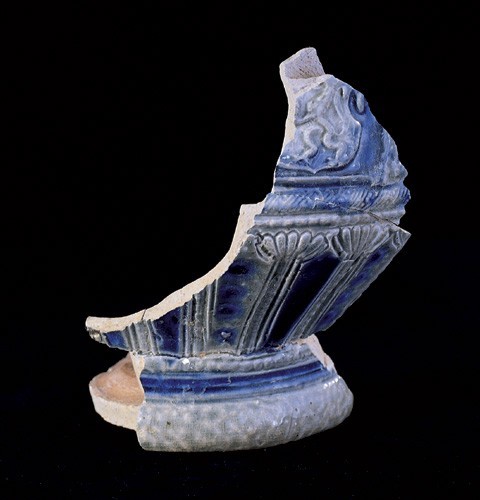
Jug fragment, Raeren, 1600–1610. Salt-glazed stoneware. (Courtesy, Association for the Preservation of Virginia Antiquities; photo, Gavin Ashworth.) This excavated example contains a portion of a mid-girth Seven Electors motif.
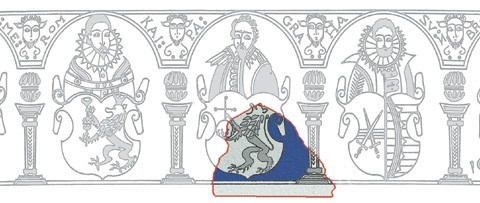
Photo illustration. (Courtesy, Association for the Preservation of Virginia Antiquities; graphic, Jamie May.) If the coat of arms on the Raeren jug from James Fort illustrated in fig. 30 had been complete, it would have depicted the bust of the count palatine of the Rhine behind his coat of arms. In 1613 King James’s daughter, Elizabeth Stuart, married Frederick V, the elector palatine and successor to Frederick IV, who is represented on the jug from James Fort.

Bottle, Frechen, Germany, ca. 1600. Stoneware. H. 8". (Courtesy, Association for the Preservation of Virginia Antiquities; photo, Gavin Ashworth.) Example excavated from the James Fort site.
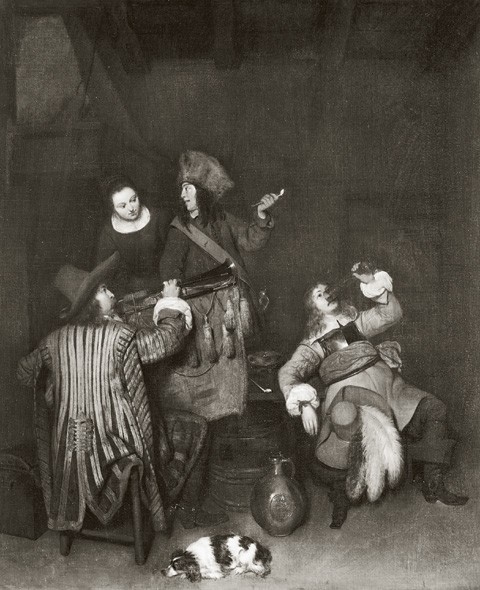
Soldiers in a Tavern, Gerald Terborch, 1658. (Courtesy, Philadelphia Museum of Art, John G. Johnson Collection.) This painting depicts a Bartmann bottle standing by the feet of a soldier who is drinking beer from a glass. These durable stoneware containers quickly evolved in status to decanters that could be used at the table in conjunction with drinking vessels made of other materials.

Bottle, Frechen, Germany, 1605. Stoneware. H. 9 1/4". (Guthman collection; photo, Gavin Ashworth.) An antique example of a single medallion Bellarmine, dated 1605.
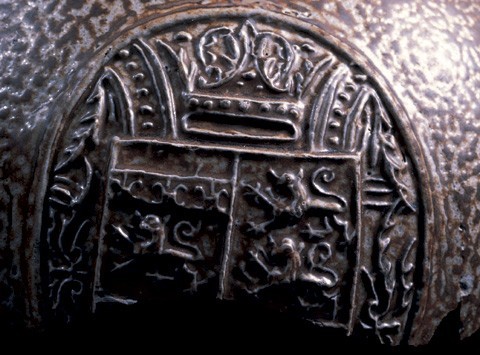
Detail of medallion on the bottle illustrated in fig. 32. (Courtesy, Association for the Preservation of Virginia Antiquities; photo, Beverly Straube.)
